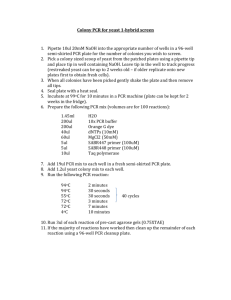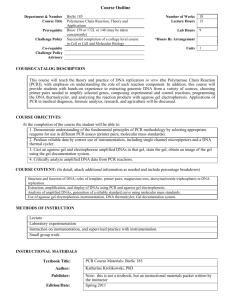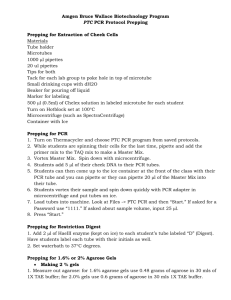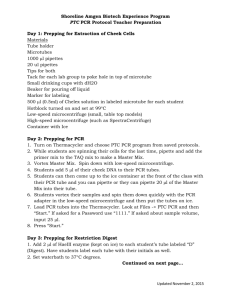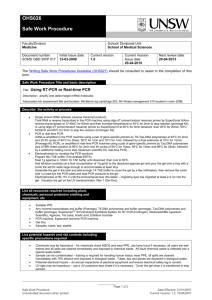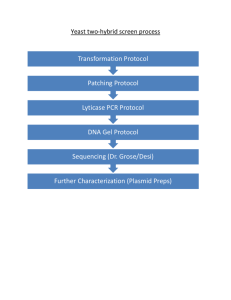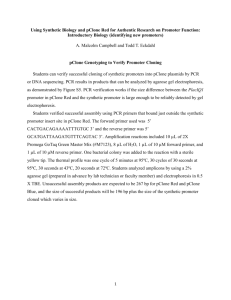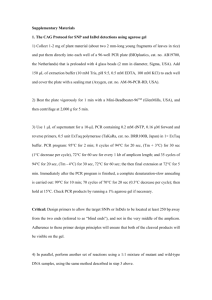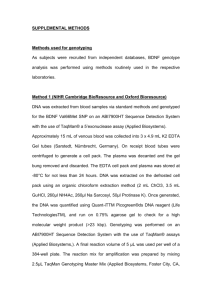S1 Text - Figshare
advertisement
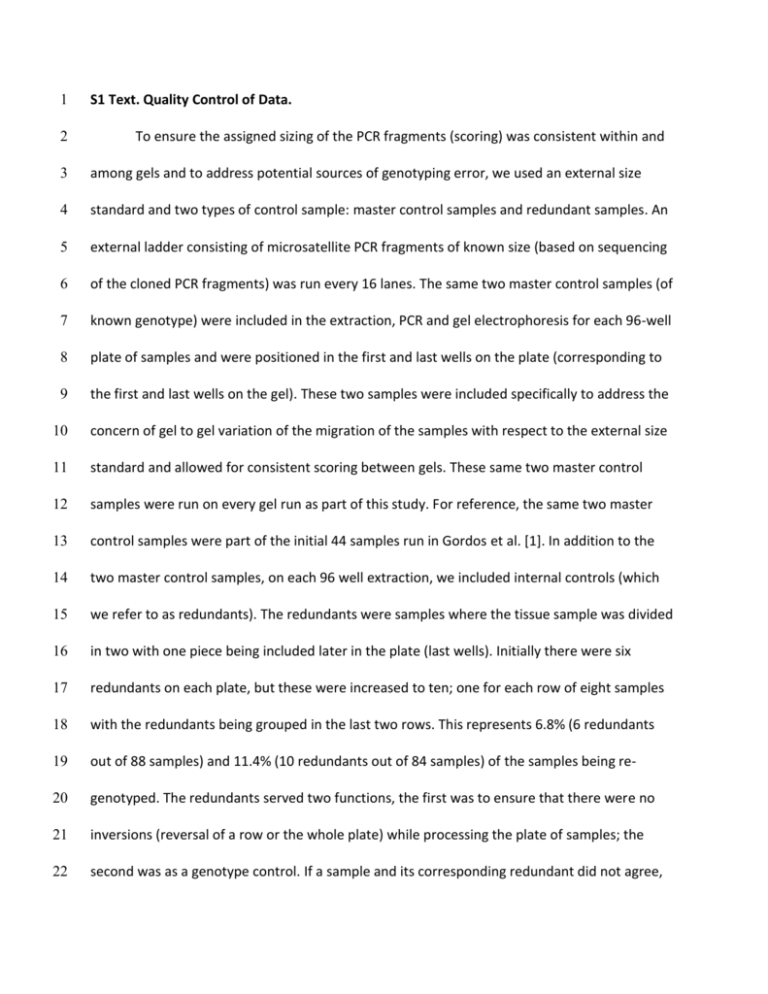
1 2 S1 Text. Quality Control of Data. To ensure the assigned sizing of the PCR fragments (scoring) was consistent within and 3 among gels and to address potential sources of genotyping error, we used an external size 4 standard and two types of control sample: master control samples and redundant samples. An 5 external ladder consisting of microsatellite PCR fragments of known size (based on sequencing 6 of the cloned PCR fragments) was run every 16 lanes. The same two master control samples (of 7 known genotype) were included in the extraction, PCR and gel electrophoresis for each 96-well 8 plate of samples and were positioned in the first and last wells on the plate (corresponding to 9 the first and last wells on the gel). These two samples were included specifically to address the 10 concern of gel to gel variation of the migration of the samples with respect to the external size 11 standard and allowed for consistent scoring between gels. These same two master control 12 samples were run on every gel run as part of this study. For reference, the same two master 13 control samples were part of the initial 44 samples run in Gordos et al. [1]. In addition to the 14 two master control samples, on each 96 well extraction, we included internal controls (which 15 we refer to as redundants). The redundants were samples where the tissue sample was divided 16 in two with one piece being included later in the plate (last wells). Initially there were six 17 redundants on each plate, but these were increased to ten; one for each row of eight samples 18 with the redundants being grouped in the last two rows. This represents 6.8% (6 redundants 19 out of 88 samples) and 11.4% (10 redundants out of 84 samples) of the samples being re- 20 genotyped. The redundants served two functions, the first was to ensure that there were no 21 inversions (reversal of a row or the whole plate) while processing the plate of samples; the 22 second was as a genotype control. If a sample and its corresponding redundant did not agree, 23 the reason was investigated before the scoring was considered to be complete for that plate. 24 When the reason for the discrepancy was determined (row inversion, artifacts from running the 25 gel (smiling, frowning), genotyping error, transcription error etc.) the genotyping of the locus 26 across the whole gel was reviewed (or the gel was rerun) and corrected as required. Based on 27 this methodology, while we did repeat samples (between 6.8% and 11.4%; see above) they 28 were not scored independently and therefore cannot be used to estimate the genotyping error 29 rate. For all loci, except Mvi9, all gels were scored independently by two readers. This was 30 included as an additional level of data control given the lack of internal (to the lane) size 31 standard and manual (as opposed to software based) scoring used with the FMBIOIII scanning 32 platform. The independent genotyping results were compared and discrepancies were 33 reconciled by consensus during re-examination of the original gel. Due to the abundance of one 34 bp allele differences, consensus reconciliation was not used for the Mvi9 locus and for 35 consistency the same person scored all Mvi9 gels. To help maintain consistency, as this project 36 was undertaken over a number of years, one of the two scorers was the same person 37 throughout the entire study. 38 Additional validation of the allele sizing for these loci was also undertaken. A subset of 39 samples (n=344) were amplified and size fractionated on an AB3130xl capillary electrophoresis 40 system (Applied Biosystems, Burlington, Canada) as this platform has higher resolution and 41 includes an internal size standard (Gene Scan 500 LIZ (Applied Biosystems, Burlington, Canada)) 42 with each sample. For this analysis, DNA samples were normalized to 20 ng µL-1. The PCR 43 reactions were done in 10 µL containing 20 ng of template DNA, 1X Type-it multiplex PCR 44 master mix (Qiagen, Mississauga, Canada) and 1X primer mix (see below). The six microsatellite 45 loci were combined in two panels. The PCR cycles consisted of one cycle of 95° C for 5 minutes, 46 thirty cycles of 95° C for 30 seconds, the annealing temperature for 3 minutes and 72° C for 30 47 seconds followed by one cycle of 60° C for 30 minutes. The annealing temperature for the first 48 panel was 55° C and for the second panel was 62° C. The primer mix for the first panel was 49 comprised of Mvi3 (labeled in PET), Mvi5 (labeled in VIC), Mvi10 (labeled in NED) and Mvi2 50 (labeled in 6FAM). The primer mix for the second panel included Mvi9 (labeled in 6FAM) and 51 Mvi16 (labeled in VIC). For Mvi9 and Mvi16, the forward primers (the unlabeled primers) were 52 synthesized with the dinucleotide + tail option (Applied Biosystems, Burlington, Canada) to 53 encourage non-template nucleotide addition (generally known as adenylation) by Taq 54 polymerase to go to completion [2]. This approach was tested with Mvi2 as well, but found to 55 have a negative impact on the interpretability of the electrophoresis results for this locus. 56 The same type of allele size differences (S2 Table) were seen with these amplification 57 and size fractionation procedures for all six loci. This included single base alleles for Mvi2, Mvi9 58 and Mvi16. The use of the tailed primers for Mvi9 and Mvi16 suggests that these single base 59 alleles are the result of sequence changes in the PCR fragment itself and not due to incomplete 60 adenylation of PCR products. These results support the fragment size interpretation (scoring) 61 used in this study. 62 Supplementary References 63 1. Gordos K, Kenchington EL, Hamilton LC, Nakashima BS, Taggart CT. Atlantic capelin (Mallotus 64 villosus) tetranucleotide microsatellites. Mol Ecol Notes. 2005; 5: 220-222. 65 2. Brownstein MJ, Carpten JD, Smith JR. Modulation of Non-Templated Nucleotide Addition by 66 Taq DNA Polymerase: Primer Modifications that Facilitate Genotyping. BioTechniques. 67 1996; 20: 1004-1010.

